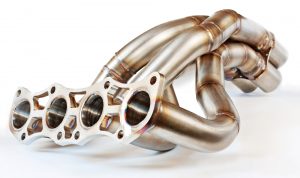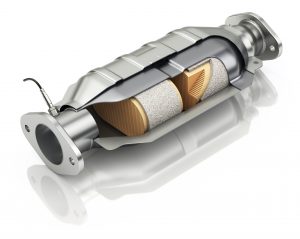Here are some reasons your exhaust system is acting up.
The exhaust system has a lot of parts that can be damaged.
From the cylinders through the manifold to the catalytic converter and beyond.
 Your car’s exhaust system is a network of connected pipes and parts designed to filter and route emissions from the engine compartment toward the rear of the vehicle. Five primary parts – oxygen sensor, exhaust manifold, catalytic converter, and muffler – are involved. Components are joined together with gaskets, or seals, to minimize leakage. As the engine burns gas to power your car, it emits gases containing water vapor, unburned fuel and acidic contaminants. The catalytic converter filters out most of the pollutants, converting the exhaust to a less toxic byproduct of carbon dioxide and water vapor. The exhaust then passes through the system of pipes, to the muffler, which all work to cool the exhaust and muffle the noise the system would make without all of these pieces in place.
Your car’s exhaust system is a network of connected pipes and parts designed to filter and route emissions from the engine compartment toward the rear of the vehicle. Five primary parts – oxygen sensor, exhaust manifold, catalytic converter, and muffler – are involved. Components are joined together with gaskets, or seals, to minimize leakage. As the engine burns gas to power your car, it emits gases containing water vapor, unburned fuel and acidic contaminants. The catalytic converter filters out most of the pollutants, converting the exhaust to a less toxic byproduct of carbon dioxide and water vapor. The exhaust then passes through the system of pipes, to the muffler, which all work to cool the exhaust and muffle the noise the system would make without all of these pieces in place.
Many of the pipes and fitments, as well as the muffler and key parts of the exhaust system live under your car, probably the worst place to be, second only to where the oil dipstick has to spend most of its life. Being on the underside of the car, these parts of the exhaust system are exposed to all kinds of hazards – road debris, crud, dirt, water, snow, ice, construction materials, old shoes, boxes. You name it. What other stuff have you witnessed discarded or lost on America’s roads? Someone we know once ran over a wood 2×4 on the highway at night. It blew a hole in and did such damage that the whole pipe system had to be replaced. Before being repaired, you could hear his car coming a mile away.
Oxygen Sensor
Road junk and highway hazards aside, there are parts of the engine that rely on and contribute to the exhaust system that are not exposed to the onslaught of the outside world. The engine pistons are in their cylinders, busy making explosions, creating heat, and generating hot, noxious gases. The gases that result from all of this have to be pushed out of the cylinders, processed into environmentally friendly, legally acceptable emissions, and passed through a piping system, and finally out the tailpipe.
All of this starts with the oxygen sensor. Located in or near the manifold, the oxygen sensor sends O2 level readings to the car’s computer, which regulates how much fuel is needed in the engine. This helps determine the best fuel mixture and efficiency. Without a properly functioning oxygen sensor, the computer can’t calculate the air/fuel mixture, which affects the engine’s performance, and this can affect many other systems as a result. For instance, if you smell gasoline as you drive, check the oxygen sensor as soon as possible.
Exhaust Manifold
 The exhaust manifold sits over the cylinder heads and collects the exhaust gases from each, through exhaust valves, and pushes them through a single pipe to the catalytic converter. It also burns any excess fuel that is not used in the engine. A leak in the exhaust manifold can burn the exhaust valves, which compromises their seals over the cylinders, and impacts the performance of the pistons, hence the engine. If the manifold is cracked or has a leak, the back pressure in the exhaust system will be incorrect, which reduces engine power. Sputtering, sluggishness, and strange noises like ticking or clicking, and other problems are all symptoms of a compromised exhaust manifold. Additionally, a damaged manifold causes slow warm-up time which results in excess fuel consumption, and in turn will cause excess wear on your catalytic converter.
The exhaust manifold sits over the cylinder heads and collects the exhaust gases from each, through exhaust valves, and pushes them through a single pipe to the catalytic converter. It also burns any excess fuel that is not used in the engine. A leak in the exhaust manifold can burn the exhaust valves, which compromises their seals over the cylinders, and impacts the performance of the pistons, hence the engine. If the manifold is cracked or has a leak, the back pressure in the exhaust system will be incorrect, which reduces engine power. Sputtering, sluggishness, and strange noises like ticking or clicking, and other problems are all symptoms of a compromised exhaust manifold. Additionally, a damaged manifold causes slow warm-up time which results in excess fuel consumption, and in turn will cause excess wear on your catalytic converter.
Over time, the constant expansion and contraction of the manifold, caused by the heating and cooling in the engine, can cause the manifold to crack and leak. These leaks permit hot toxic gases to escape, which can damage other components in the engine compartment. A leaking exhaust manifold can also affect engine performance. Some symptoms of a cracked, leaking manifold include:
- Excess, unfamiliar noise from engine.
- Low engine performance.
- Check engine light is on.
- Smells from the engine compartment – burning, melting.
Catalytic Converter
 The catalytic converter, even though it is on the underside of the car, sits cozily within its own secure, hard case just behind the engine. Once exhaust gases leave the cylinders and pass through the manifold, they flow into a single pipe toward the catalytic converter. This important piece comes after the exhaust manifold and serves to convert the harmful carbon monoxide and hydrocarbon gases into carbon dioxide and water vapor, making the exhaust safer for the environment.
The catalytic converter, even though it is on the underside of the car, sits cozily within its own secure, hard case just behind the engine. Once exhaust gases leave the cylinders and pass through the manifold, they flow into a single pipe toward the catalytic converter. This important piece comes after the exhaust manifold and serves to convert the harmful carbon monoxide and hydrocarbon gases into carbon dioxide and water vapor, making the exhaust safer for the environment.
Some converters also reduce harmful nitrogen oxides. If the odor you are smelling is like rotten eggs, then the catalytic converter is probably failing. The rotten egg smell is because the converter is not breaking down the sulfur pollutants created by the engine. Catalytic converters can’t be repaired – they must be replaced.
Muffler
 The muffler does exactly what its name implies – it muffles the extreme levels of noise produced by the combustion process (explosions) in the engine and noise throughout the exhaust system. The sounds of the combustion process travel through the system, to the muffler. The muffler is a metal chamber attached to the tailpipe assembly at the rear of the car. It contains a series of baffles that sound must travel though. As the sound traverses the baffles, it dissipates. At the end of the muffler is the resonator, which cancels out the sound waves.
The muffler does exactly what its name implies – it muffles the extreme levels of noise produced by the combustion process (explosions) in the engine and noise throughout the exhaust system. The sounds of the combustion process travel through the system, to the muffler. The muffler is a metal chamber attached to the tailpipe assembly at the rear of the car. It contains a series of baffles that sound must travel though. As the sound traverses the baffles, it dissipates. At the end of the muffler is the resonator, which cancels out the sound waves.
What about that water dripping out of the tailpipe?
If you see liquid dripping out of the tailpipe, don’t panic. It normal and harmless condensation of water vapor This is caused by the exhaust system getting really hot, then cooling down, which causes moisture to collect, or condense, in the muffler and pipes. It then manages to flow and drip out the tailpipe.
Exhaust Leaks
An exhaust leak is dangerous, as the fumes contain carbon monoxide and could potentially get into the cabin of your car. When the exhaust system isn’t working correctly, extra heat flows into the engine. This damages the catalytic converter. The best thing to do is to take your car to a muffler repair shop where they can insert a new section of pipe or component to make sure your exhaust system is tight and leak-proof.
Noises & Performance
A chugging or rhythmic hissing noise could mean a blockage in the exhaust system. Additionally, loud, abnormal sounds will come from the engine area, and/or the tailpipe. If you hear rattling under the car it could mean that the exhaust system has become loose, misaligned, or disconnected. If you hear a loud metallic vibration, it usually means that something is touching the exhaust pipe or that a mounting is loose.
Find Your Locally Owned & Operated AAMCO Minnesota Auto Repair Center
Schedule Your Appointment Today
If you have any questions, feel free to call and talk with one of our courteous technicians. Or, fill out the form below to reserve your time, date, and location.
